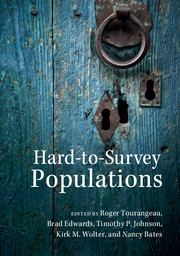Book contents
- Frontmatter
- Dedication
- Contents
- List of figures
- List of tables
- List of boxes
- List of contributors
- Preface
- Part I Introduction
- Part II Conducting surveys in difficult settings
- Part III Conducting surveys with special populations
- 11 Representing the populations: what general social surveys can learn from surveys among specific groups
- 12 Surveying cultural and linguistic minorities
- 13 Challenges to surveying immigrants
- 14 Ethnographic evaluations on coverage of hard-to-count minorities in US decennial censuses
- 15 Methodological and ethical issues arising in carrying out research with children and young people
- 16 Challenges in the first ever national survey of people with intellectual disabilities
- 17 Conducting research on vulnerable and stigmatized populations
- 18 Surveying political extremists
- Part IV Sampling strategies for the hard to survey
- Part V Data collection strategies for the hard to survey
- Index
- References
13 - Challenges to surveying immigrants
Published online by Cambridge University Press: 05 September 2014
- Frontmatter
- Dedication
- Contents
- List of figures
- List of tables
- List of boxes
- List of contributors
- Preface
- Part I Introduction
- Part II Conducting surveys in difficult settings
- Part III Conducting surveys with special populations
- 11 Representing the populations: what general social surveys can learn from surveys among specific groups
- 12 Surveying cultural and linguistic minorities
- 13 Challenges to surveying immigrants
- 14 Ethnographic evaluations on coverage of hard-to-count minorities in US decennial censuses
- 15 Methodological and ethical issues arising in carrying out research with children and young people
- 16 Challenges in the first ever national survey of people with intellectual disabilities
- 17 Conducting research on vulnerable and stigmatized populations
- 18 Surveying political extremists
- Part IV Sampling strategies for the hard to survey
- Part V Data collection strategies for the hard to survey
- Index
- References
Summary
Introduction
In the last quarter of the twentieth century, virtually all developed nations became countries of immigration. International migration is inextricably bound to the globalization of the economy. As international trade and investment expand and markets penetrate more deeply into regions and sectors that were formerly outside or on the margins of global capitalism, the structural organization of society shifts in ways that accelerate geographic mobility (Massey, 1988). Since industrialization first permitted the global expansion of markets beginning in the early nineteenth century, two eras of globalization have prevailed (Hatton & Williamson, 2006; Massey, 2009; Williamson, 2004).
The first occurred during the nineteenth and early twentieth centuries and involved exchanges between the industrializing nations of Europe and their overseas extensions – settler societies in the Americas and Oceania and colonies in Africa and Asia. From 1846 to 1924, some 48 million migrants left Europe in response to the dislocations of industrialization, with more than 60 percent going to the United States and the rest proceeding mainly to Canada, Argentina, Brazil, and Australia (Massey, 1988). This first era was curtailed in 1914 by World War I, which squandered massive amounts of capital and labor in the trenches and destroyed the international order on which trade and commerce had rested (O’Rourke & Williamson, 1999).
- Type
- Chapter
- Information
- Hard-to-Survey Populations , pp. 270 - 292Publisher: Cambridge University PressPrint publication year: 2014
References
- 11
- Cited by

